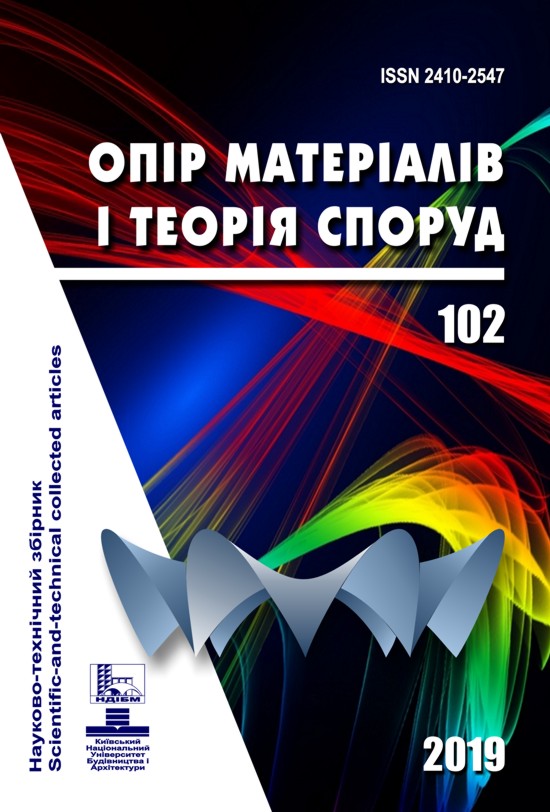Stress-strain state of beam corrugated web under patch loading
DOI:
https://doi.org/10.32347/2410-2547.2019.102.53-61Keywords:
corrugated web, stress-strain state, strength condition, patch loadingAbstract
One of the insufficiently resolved problems related to the use of steel I-beams with sinusoidally corrugated webs that are becoming more popular in modern building practice is a behavior of its webs under patch loadings.
According to modern design codes corrugated webs of welded beams under patch loading action via on of the flanges in the web plane should be checked for strength under the condition of elastic behavior of steel. But nowadays standard scientific justified technique for such analyses is absent.
This paper proposes numerically analytic method for corrugated web limit state determination under patch loading, which is based on stress-strain state analysis via FEM of physico-mathematical models created according to standard corrugated profiles range of company Zeman.
In the strength analysis the beams were modeled by finite elements of thin shell under the condition of elastic behavior of steel. It’s established that the web height practically don’t have an effect on the values of normal stresses at the level of its connection with the flange. The web thickness and the distribution length of the patch loading exert the main impact on the value of local stresses.
A generic table that allows finding all necessary data to determine the maximum value of local patch loading under the condition of steel elastic behavior was developed. In the cases when flange thickness or distribution length of the patch loading is different to the table values it is necessary to use the linear interpolation method.
Considering that in the area of local stresses the tangential stresses act simultaneously with the normal stresses, the web strength is proposed to be checked by the Huber-Mises-Hencky criterion.
The application of the developed technique makes it possible to determine with a given accuracy the value of local stresses in the web and, if necessary, to correct its thickness or the flange thickness. This procedure allows refining the required web thickness when patch local loading affects it and, thus, reduces consumption of steel.
References
Eurocode No. 3 Design of Steel Structures. Part 1.1. General rules and rules for buildings (European Prestandard ENV-1993-1-1).
Eurocode No. 3, Design of Steel Structures. Part 1.5. Plated structural elements (EN 1993-1-5, 2008).
Siokola W., Wellstegträger. Herstellung und Anwendung von Trägern mit profiliertem Steg. — Stahlbau 9/1997. — P. 596 — 605.
Ramberger G., Gutachten über die Berechnung von Geschweissten I-Trägern Mit Stegen Aus Gewellten Blechen. — O. Univ., Wien 1989 — not published.
Pasternak H., Brańka P., Tragverhalten von Wellstegträgern unter lokaler Lasteinleitung. — Bauingenieur 5/1999. — P. 219 — 224.
Kuchta K.R., Nośność i Sztywność Blachownic o Falistych środnikach. — Politechnika Krakowska. — Kraków 2004.
Broude B.M., Raspredelenie sosredotochennogo davleniya v metallicheskih balkah. (Distribution of concentrated pressure in metal beams) — Stroyizdat, Moskva — Leningrad 1950.
Luo R., Edlund B., Strength of Plate Girders with Trapezoidally Corrugated Webs in Shear or under Patch Loading — Proceedings of Nordic Steel Construction Conference, Malmö, — 1995, — P. 79 — 86.
Luo R. and Edlund B., Shear Capacity of Plate Girders with Trapezoidally Corrugated Webs. — Thin-Webed Structures, — 1996, Vol. 26, No. 1, — P. 19 — 44.
Kuchta K.R., Design of corrugated webs under patch load. — Advanced Steel Construction, — 2007, — Vol. 3, — No. 4. — P. 737 — 751. https://doi.org/10.18057/IJASC.2007.3.4.3
Downloads
Published
Issue
Section
License
Authors retain copyright and grant the journal right of first publication with the work simultaneously licensed under a Creative Commons Attribution License that allows others to share the work with an acknowledgement of the work's authorship and initial publication in this journal.

